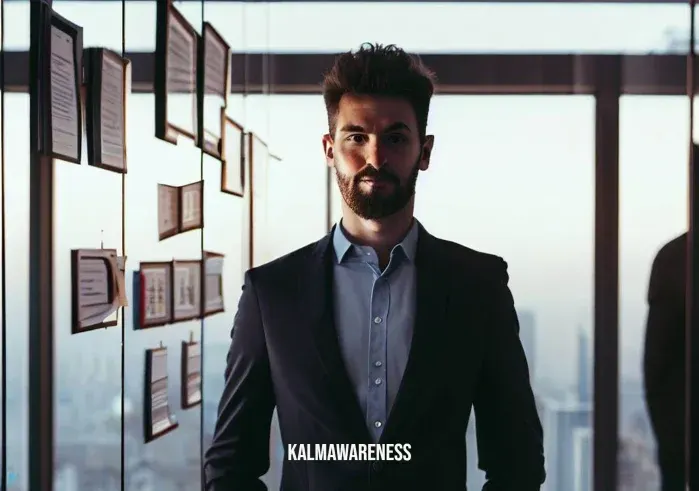What Do You See When You Look in the Mirror?
Each day, we engage in the simple yet profound act of looking in the mirror. We may see just a reflection, but is that all there really is? The question, what do you see when you look in the mirror, delves into a deeper narrative of self-perception, self-awareness, and identity.
Reflecting Upon Your Reflection
When you glance at your reflection, do you truly see who you are? The person staring back from the mirror could be perceived differently based on your current emotions, feelings, and self-esteem.
This raises the question, do we look like what we see in the mirror? Our appearance in the mirror can vary drastically from day to day. Sometimes we look different in every mirror, as each mirror might distort our reflection in its unique way. The image we perceive can be influenced by lighting, mirror quality, and even the angle at which we look at ourselves.
Interpreting Our Self-image
Our interpretation of our reflection is not only about physical appearance. It’s also a reflection of our self-perception and self-esteem. If you’re struggling with low self-esteem, you might look in the mirror and not like what you see. This could also apply to emotional or psychological aspects that are mirrored back to us.
We may see someone else in the mirror when our self-perception doesn’t align with reality. In other instances, we may look in the mirror and don’t recognize ourselves due to a disconnection from our self-identity.
The Mirror as a Tool for Self-discovery
“The mirror reflects all things beautifully, but it doesn’t create beauty.”
The mirror can be a potent tool for self-discovery and growth. Mirror activities can help us to reconcile with our reflection and build self-esteem.
Mirror gazing experiences can be profound, creating a gateway to inner introspection and self-discovery. It’s an opportunity to look beyond our physical appearance and delve deeper into our psyche.
At the end of the day, it’s not about how good you look in the mirror, but how you feel about yourself that truly matters.
The Psychology of Mirror Image Perceptions
Our mirror image is more than a physical reflection; it’s a projection of our self-concept and inner emotions. The concept of mirror image perceptions in psychology delves deeper into this topic. It explores the influence of our perceptions and feelings on the image we see in the mirror.
I invite you to join me in the second part of the article where we’ll explore the connection between mirrors and personal growth. We’ll delve into the intriguing idea of the mirror as a metaphor for self-perception, delve into why self-love can be so hard, and explore techniques to foster a healthier relationship with our mirror images. Stay tuned!

Diving Deeper into Mirror Reflections and Personal Growth
In this next segment of our exploration into the question what do you see when you look in the mirror, we are going to navigate through the connection of our reflection with personal growth, the challenge of self-love, and ways to enhance our self-perception.
Our Reflection and Personal Growth
Our mirror reflections can serve as a mirror of the mind, a tool for introspection and personal development. They give us a chance to confront and accept our physical selves while challenging us to delve deeper into our psychological and emotional selves.
When you look in the mirror, you are essentially looking at the person in front of the mirror, seeing yourself from a third-person perspective. This can foster a heightened self-awareness that propels personal growth.
Self-Love: A Difficult Journey
In the journey of self-discovery and acceptance, we often find why self-love is so hard. The answer to this is multifaceted, ranging from societal pressures and expectations, personal insecurities, and past traumas.
Let’s break this down into a simple list for better understanding:
- Societal Pressures: Society often dictates standards of beauty and success, making us feel inadequate when we don’t measure up.
- Personal Insecurities: Our insecurities often distort our mirror image, causing us to see flaws that may not exist.
- Past Traumas: Negative experiences and traumas can impact our self-perception, making self-love a challenging task.
When you look at yourself in the mirror, try to acknowledge these factors and remind yourself that self-love is a journey, not a destination.
Techniques for Better Self-perception
Enhancing your self-perception involves adjusting the way you perceive your reflection. Here are some techniques you can practice:
- Affirmations: Write positive affirmations and things to write on your mirror, such as “I am enough,” “I am beautiful,” or “I am worthy.” This can help to shift your focus from negatives to positives.
- Mindfulness: Practice mindfulness when you look in the mirror. Be present in the moment, acknowledging your reflection without judgment.
- Self-Talk: Engage in positive self-talk, combatting negative thoughts and beliefs about your appearance and worth.
Below is a table that shows the relationship between these techniques, their purpose, and their benefits:
| Technique | Purpose | Benefits |
|---|---|---|
| Affirmations | To shift focus from negatives to positives | Increases self-esteem and promotes positive thinking |
| Mindfulness | To be present in the moment without judgment | Encourages acceptance and reduces self-criticism |
| Self-Talk | To combat negative thoughts and beliefs | Enhances self-perception and fosters self-love |
As we wrap up this chapter, we would like to invite you to continue to the next part of this journey. We’ll delve deeper into the idea of mirrors facing each other, the perception of ‘I am,’ and more intriguing facets of self-perception and personal growth. See you in the next chapter!

The Role of Mirrors in Exploring our Identity
In the next phase of this journey into understanding what do you see when you look in the mirror, we delve into how mirrors aid us in self-exploration and understanding our identity. We will also consider the intriguing phenomenon of seeing our reflection as someone else and discuss some quotes from thought leaders in the field of self-perception and identity.
Mirrors and Self-Identity
When it comes to self-identity, what we see in the mirror often shapes our perception of ourselves. The reflection provides a tangible image that becomes a part of our identity construction process. Each glance at the mirror is an opportunity for us to evaluate, reevaluate, and reconstruct our identity.
Carl Rogers, a renowned psychologist, once said, “The only person who is educated is the one who has learned how to learn and change.” In the process of identity formation, change is inevitable and necessary, and the mirror often acts as a silent facilitator in this.
Seeing Someone Else in the Mirror
An interesting aspect to ponder upon is the experience of seeing someone else in the mirror. This could be a projection of our subconscious desires, fears, or unprocessed emotions. Our mind sometimes uses our reflection as a canvas to project these suppressed aspects of our identity.
The insightful Robin Stern once commented, “We do not see things as they are, we see them as we are.” When you look in the mirror and see someone else, it might be your mind’s way of making you see aspects of yourself that you haven’t fully acknowledged or understood.
Quotes on Self-perception and Identity
Let’s now delve into some insightful quotes that provide a deeper understanding of self-perception and identity.
- “You use a glass mirror to see your face; you use works of art to see your soul.” – George Bernard Shaw. The idea behind this quote is akin to using our reflection as a tool for soul-searching and introspection. The act of looking in the mirror can become a form of art that reveals our deepest selves.
- “The face is the mirror of the mind, and eyes without speaking confess the secrets of the heart.” – St. Jerome. This quote emphasizes the powerful expressiveness of our eyes. When you look at your eyes’ reflection, you can often catch a glimpse of your emotional state.
- “The mirror reflects all objects without being sullied.” – Confucius. This quote reflects the neutrality of the mirror. Regardless of our feelings, our mirror reflection remains unchanged, offering a pure representation of our physical selves.
As we conclude this chapter, we invite you to continue onto the next part of this enlightening journey. In the next chapter, we will discuss how mirrors are used in various techniques and practices to facilitate personal growth, understand the complex phenomenon of ‘mirror gazing,’ and more. The journey of self-discovery continues; see you in the next chapter!

Reflection and Personal Growth: The Mirror as a Tool for Self-Improvement
As we continue to delve into the subject of what do you see when you look in the mirror, the next chapter of our discussion will focus on the concept of using the mirror as a tool for personal growth and self-improvement. We will also explore some motivational quotes that inspire hope and confidence.
Using the Mirror for Personal Growth
One unique aspect of mirrors is their potential use as tools for personal growth and development. Certain techniques, such as the Mirror of the Mind Technique, utilize mirrors to facilitate self-understanding and growth.
When you look in the mirror, it’s not just about acknowledging your physical appearance. It’s also about confronting your internal realities, feelings, and perceptions. Seeing your reflection can initiate an internal dialogue, a form of self-talk that guides you toward deeper self-understanding.
One might even write affirmations or meaningful quotes on their mirror as a form of positive reinforcement. The mirror, in essence, becomes a canvas for self-expression and self-improvement. There are plenty of things to write on your mirror that can inspire personal growth.
Mirror Gazing
Another fascinating practice that focuses on mirror use is Mirror Gazing. This practice involves staring at your own reflection in the mirror for extended periods. It encourages self-awareness and introspection, leading to personal growth and a deeper understanding of oneself.
Quotes that Inspire Hope and Confidence
In the journey of personal growth and self-improvement, it’s crucial to stay motivated and maintain a positive outlook. Let’s consider some inspirational quotes that can instill hope and confidence when one sees their reflection:
- “The greatest discovery of all time is that a person can change his future by merely changing his attitude.” – Oprah Winfrey. This quote emphasizes the power of perspective. When you look in the mirror, consider it an opportunity to shape your future through self-awareness and attitude adjustment.
- “Believe you can and you’re halfway there.” – Theodore Roosevelt. Every glance in the mirror can serve as a reminder of your capabilities and potential.
- “The only way to do great work is to love what you do.” – Steve Jobs. When you look in the mirror, it’s important to see a person who is passionate about their pursuits.
Prominent Personal Growth Concepts and their Founders
| Concept | Description | Founder |
|---|---|---|
| Mirror of the Mind Technique | A practice that uses visualization and the metaphor of a mirror to create a mental space for self-improvement. | Jose Silva |
| Mirror Gazing | A technique of self-observation and introspection that uses your reflection as the focus point. | Various |
| Mirror Activity | Involves performing specific activities in front of a mirror to boost self-confidence and promote self-awareness. | Various |
| Mirror Therapy | A therapeutic technique used to improve or restore self-perception and motor control. | V.S. Ramachandran |
| Self-affirmation | The practice of positive self-talk or personal messaging to promote a positive self-image. | Claude M. Steele |
This chapter closes on the note that mirrors can serve as a tool for personal growth and introspection, driving us towards self-improvement. In the next chapter, we’ll delve deeper into the role of self-esteem in the perception of our mirror image and how to foster a positive self-image. Keep reading to continue this journey of self-discovery.

The Role of Self-Perception in the Mirror Image: A Comprehensive Analysis
Delving deeper into the subject of “what do you see when you look in the mirror?”, we now explore a significant facet that greatly influences our mirror image: self-perception. This chapter intends to offer fresh insights and explore new dimensions associated with our topic.
The Power of Self-Perception
Self-perception, in essence, refers to the way we view ourselves, shaping our personal image, attitudes, and behaviours. It’s the mental picture we hold of ourselves. When we look in the mirror, we don’t merely see a physical reflection, but a blend of our attitudes, values, strengths, weaknesses, and beliefs. It’s our self-perception that mainly determines what we see when we look in the mirror.
An article from Perception and Personality sheds more light on how our perception shapes our personality and, in turn, our self-image.
Self-Perception Theory
The self-perception theory by Bem suggests that we determine our attitudes and emotions by observing our own behaviour. Here’s a good read from Psychology of Self-Perception that elucidates the self-perception theory more elaborately.
Consider a situation where you’re standing in front of a mirror, rehearsing for a public speaking engagement. As you speak confidently and articulately, you start to believe that you are indeed confident and eloquent. This, in essence, demonstrates Bem’s self-perception theory.
The Mirror: A Tool for Changing Self-Perception
Just as mirrors can reveal physical aspects that need change, they can also reveal areas of self-perception that might need altering. When we look in the mirror and perceive a confident, self-assured individual, we foster positive self-perception. On the contrary, when we see ourselves as lacking or deficient, we nurture negative self-perception.
Consider reading more about how mirrors can change our self-perception in this article: Mirrors and Perception: How Mirrors Can Change How We See Ourselves.
Shifting Your Self-Perception
Altering self-perception is a transformative process that begins with self-awareness. When we look in the mirror, it’s critical to question our self-perception consciously. Are we too harsh or judgmental towards ourselves? Do we focus more on our flaws and less on our strengths? Understanding these aspects can help us shift our self-perception from negative to positive.
For a detailed guide on altering self-perception, you can check the article Shifting Your Perception: A Guide.
Self-Perception and Mental Health
The connection between self-perception and mental health is a crucial topic in psychology. A negative self-perception can lead to issues like low self-esteem, depression, and anxiety. Conversely, a positive self-perception can promote better mental health and overall well-being. This comprehensive article on Self-perception and Mental Health discusses the topic more extensively.
In conclusion, self-perception plays a substantial role in what we see when we look in the mirror. It serves as a mental framework that moulds our self-image. The next chapter will delve deeper into the role of societal and cultural influences on our mirror image. Keep reading to uncover more layers of this intriguing journey of self-discovery.

Reflections: Mirroring the Multifaceted Self
As we draw to the concluding chapter of this enlightening journey, we circle back to the central question: “What do you see when you look in the mirror?” The answer, as we have discovered, is not simply a physical reflection but a deep manifestation of self-perception, societal influences, and cultural conditioning. This chapter will cap off our discourse by looking at how these elements combine and interplay to paint the vivid image we encounter in our reflection.
The Multidimensional Mirror Image
When you stand before a mirror, what you see is a complex amalgamation of numerous factors. The Complexities of the Self gives a comprehensive overview of this multifaceted phenomenon. Your physical appearance, emotional state, mental conditioning, cultural context, and social influences, among other factors, all come together to create the image in the mirror.
Mirroring Emotions
Ever noticed how a simple smile or frown in the mirror can shift your mood? Our mirror image can serve as a barometer of our emotional state. A delighted face in the mirror could brighten up a gloomy day, while a sad expression might prompt introspection or a change in attitude. Explore the intricate connections between facial expressions, emotions, and our self-perception in Mirror and Emotions: An Interplay.
Mirrors in Different Cultures
The role and symbolism of mirrors vary across different cultures, significantly influencing what individuals see in their reflections. Some cultures view mirrors as spiritual portals, while others use them as metaphysical tools for self-discovery. For instance, in Japanese culture, the mirror (‘kagami’) symbolizes truth because it merely reflects what is before it. Read more about the fascinating interpretations of mirrors in different cultures in Mirrors Around the World.
The Transformative Power of the Mirror
Despite its static nature, the mirror can be a catalyst for change. It reflects not just who we are, but also who we could become. Recognizing this potential, many psychologists use mirror work therapy to help people improve self-perception and develop positive habits. Discover more about this transformative practice in the article Mirror Work: A Tool for Self-improvement.
Conclusion: The Mirror as a Journey
As we conclude, it’s clear that the mirror serves not just as a reflector of our physical selves but also as a window into our internal world. The question “what do you see when you look in the mirror?” serves as a gateway into this intricate exploration of the self.
Our journey through this topic may be drawing to a close, but the exploration of the self is a never-ending quest. As the great philosopher Socrates famously said, “The unexamined life is not worth living.”
We invite you to continue exploring, questioning, and evolving. After all, the mirror reflects not just who we are, but also who we have the potential to become. For more enriching content on psychology and personal development, consider subscribing to our magazine and explore our other articles.
Thank you for journeying with us and we look forward to welcoming you back to Psych Persona soon.
Whether you’re looking at your reflection in the mirror or the depths of your psyche, remember, every journey begins with a single step, or in this case, a single gaze. What will you see when you look in the mirror next time?





